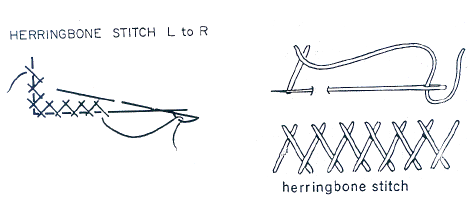These stitches are also called embroidery stitches, Decorative stitches
should always be worked with crewel needle. They re always worked
on the right sides of fabrics to make them more attractive. These types
of stitches are often worked on table cloth, pillow slip, children’s
clothes, women’s dresses such as caftan, bou-bou , Kitenge and blouses. The
starting, finishing and joining of embroidery threads should not be seen.
The final work should be neat and attractive. Knots should not be used
when working decorative stitches. There are many types of decorative
stitches. Examples are chain stitch, herringbone stitch, satin stitch.
Others are cross stitch, blanket stitch and so on.
a). Chain Stitch
-Chain stitch is produced by series of loops on the surface of the fabric.
-It is used as an outline stitch. The appearance of chain stitch looks like a line of backstitches on the wrong side of fabric.
Working
1) Begin the stitch with a back stitch
2) Bring out the needle on the line of stitching
3) Hold the thread firmly and insert the needle into the thread hole.
4) Bring the same thread out and allow a short length of thread over
and above the loop of thread
5) The loop should be tightly pulled and return the needle back into
the same hole
6) Repeat the stitch until work is completed.
b). Herringbone Stitch
This stitch is worked from left to right. The stitches should of the same depth and the space between the stitches should be equal.
working
- Begin the stitch with one or two backstitches
-Put the needle on the lower line
-Make a small backstitch along the top line leaving a short space
on the top line.
-Go back to the bottom line and make another backstitch
- Repeat these two processes along the fabric.

Satin Stitch
This is an embroidery stitch. It is used to fill in shapes of different sizes.
It is worked from the top down.
Working
1) Begin with a back stitch
2) Draw out the needle on the left hand side of the fabric
3) Put the needle point at the top right hand side of the fabric.
4) Draw the needle out on the left hand side nearer to the thread at
the beginning. Ensure that the next stitch touches the previous one.
Insert on the right hand side to touch the previous stitch and so on. It is very important that this stitch is worked very evenly and that the stitches are quite parallel.
Sometimes to give a better effect the stitch is worked diagonally across the shape. Be careful never to make the stitches too long, or they will be easily pushed out of position, especially during laundering.
Sometimes a raised effect can be more attractive. This is obtained by working a' few running stitches in a small area, or chain stitches in a larger area, before working the satin stitch
marto answered the question on
May 2, 2019 at 07:42